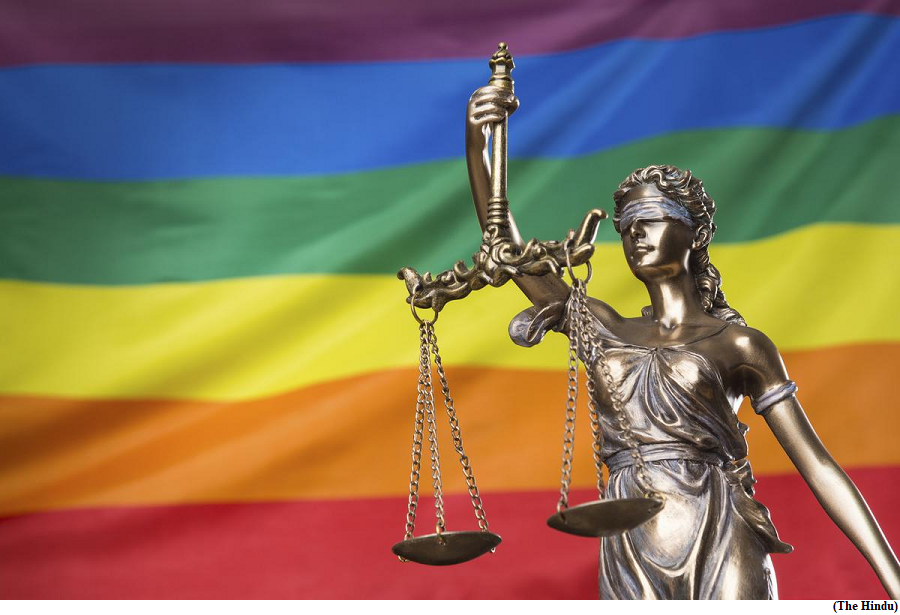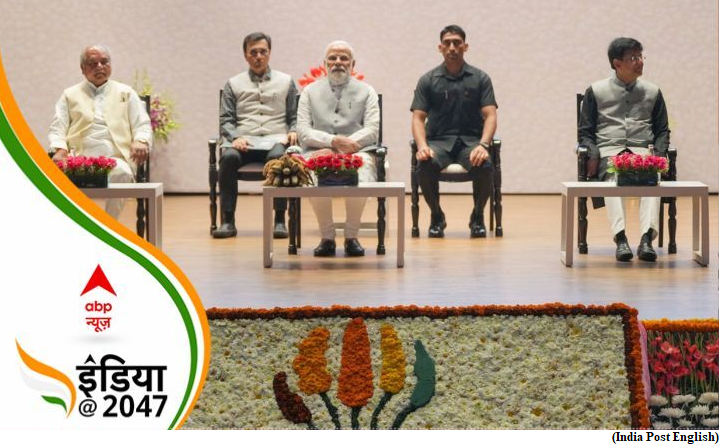What is India’s stand on same-sex marriage? (GS Paper 1, Social Issues)

Why in news?
- Recently, a Bench led by Chief Justice of India D.Y. Chandrachud referred petitions to legally recognise same-sex marriages to a Constitution Bench of five judges of the Supreme Court.
- The Court has listed the case for final arguments on April 18.
What is the case?
- The Court has been hearing multiple petitioners’ requests for legal recognition of same-sex marriages under a special law.
- Initially, it took up the case of two partners who said the non-recognition of same-sex marriage amounted to discrimination that strikes at the root of “dignity and self-fulfilment” of LGBTQIA+ couples.
- The petitioners cited the Special Marriage Act, 1954, which provides a civil marriage for couples who cannot marry under their personal law, and appealed to the Court to extend the right to the LGBTQIA+ community, by making the “marriage between any two persons” gender neutral.
Why does the community want this right?
- Even if LGBTQIA+ couples may live together, legally, they are on a slippery slope. They do not enjoy the rights married couples do.
- For example, LGBTQIA+ couples cannot adopt children or have a child by surrogacy; they do not have automatic rights to inheritance, maintenance and tax benefits; after a partner passes away, they cannot avail of benefits like pension or compensation.
- Most of all, since marriage is a social institution, “that is created by and highly regulated by law,” without this social sanction, same-sex couples struggle to make a life together.
Which way are the Courts leaning?
- The Courts, leaning on Article 21 that guarantees the right to life and liberty, have time and again ruled in favour of inter-faith and inter-caste marriages, directing the police and other rights organisations to give them protection when they were threatened by parents or society, pointing out that “all adults have the right to marry a person of their choice.”
- In Navtej Singh Johar (2018), when homosexuality was decriminalised, the Court said, “Members of the LGBT[QIA+] community are entitled to the benefit of an equal citizenship, without discrimination, and to the equal protection of law”; “The choice of whom to partner, the ability to find fulfilment in sexual intimacies and the right not to be subjected to discriminatory behaviour are intrinsic to the constitutional protection of sexual orientation.”
- Last November, the Court transferred same-sex cases pending before several High Courts to itself.
What is the Centre’s stand?
- At depositions in courts and outside, the Centre has opposed same-sex marriage, and said judicial interference will cause “complete havoc with the delicate balance of personal laws”.
- While filing a counter-affidavit during this hearing, the government said that decriminalisation of Section 377 IPC does not give rise to a claim to seek recognition for same-sex marriage.
- After the K.S. Puttaswamy verdict (2017) which upheld the right to privacy and Navtej Singh Johar (2018) that decriminalised homosexuality, there was hope that same-sex marriages would be legalised, but that has not been the case, prompting many couples to move court.
- In its affidavit filed in the Supreme Court, the government said that the “notion of marriage itself necessarily and inevitably presupposes a union between two persons of the opposite sex. This definition is socially, culturally and legally ingrained into the very idea and concept of marriage and ought not to be disturbed or diluted by judicial interpretation.”
- It submitted that despite the decriminalisation of Section 377 of the Indian Penal Code, the petitioners cannot seek same-sex marriage to be treated as a fundamental right and be recognised under the laws of the country.
- The government submitted that statutory recognition of marriage as a union between a ‘man’ and a ‘woman’ is inextricably tied to acceptance of the heterogeneous institution of marriage and acceptance of Indian society based on its own cultural and sociological norms acknowledged by the competent legislature.
Are the executive and the judiciary on opposing sides on this?
- With the government saying that the concept of marriage “ought not to be disturbed or diluted by judicial interpretation,” and the Court leaning towards granting equal rights, including marriage of same-sex couples, citing the Constitution and changing norms, it is clear that the two organs of the state are not in agreement on this.
- Even if the Court rules in its favour, the march towards equality for the LGBTQIA+ community will be hard. Enforcing something like same-sex marriage in a diverse country with well-entrenched traditions will not be easy.
- Rights activists are calling for awareness on sex, gender and constitutional rights from the school level to change things on the ground.
APEDA organizes Global Millets (Shree Anna) Conference
(GS Paper 3, Economy)
Why in news?
- Recently, the Agricultural and Processed Food Products Export Development Authority (APEDA), Ministry of Commerce and Industry, has organized the Global Millets (Shree Anna) Conference at Subramaniam Hall, NASC Complex, Pusa Road, New Delhi to stimulate the exports of millets from India and provide market linkage to the producers.

Participants:
- Around 100 Indian millet exhibitors from different parts of the country and around 100 international buyers from various countries like the USA, UAE, Kuwait, Germany, Vietnam, Japan, Kenya, Malawi, Bhutan, Italy and Malaysia have been invited to the Conference.
- APEDA requested 30 potential millet importing countries to send their major buyers for this conference to visit the exhibition and travel around the stalls of 100 exhibitors of unique products of millets.
Indian exports of Millets:
- India’s export of Millets is 64 million USD in the year 2021-22. There is an increase in export of Millets by 12.5 % during the period April-December 2023 as compared to the same period last year. Export of millets has witnessed a change in paradigm in the last decade.
- The major importing countries were USA, Australia, Japan, Belgium etc in 2011-12 which had been shifted to Nepal (USD 6.09 million), UAE (USD 4.84 million) and Saudi Arabia (USD 3.84 million) in 2021-22. Kenya, Pakistan were also among the potential import destinations of India in the last decade.
- The other seven destinations in the current top-ten list of India’s millet export are Libya, Tunisia, Morocco, UK, Yemen, Oman and Algeria. India is exporting millets to 139 countries across the globe. The export of value-added products of Indian millets are also spread across the world.
Millets in India:
- India is the largest producer of millets. The country is enriched with a wide range of millets produced in major millet-growing states like Rajasthan, Maharashtra, Karnataka, Andhra Pradesh, Madhya Pradesh, etc. India produced 17.96 million Metric Tonne (MT) of Millets.
- Millet grown in India are Pearl Millet, Sorghum, Finger Millet and minor Millets like Proso Millet, Kodo Millet, Little Millet, Foxtail Millet, Browntop Millet, Barnyard Millet, Amaranthus and Buckwheat.
- The Indian government has also been promoting Millet production as part of its National Food Security Mission. As a result of these factors, millet production in India is expected to continue to grow in the coming years.
Initiatives by APEDA:
- APEDA participated in the opening ceremony of the International Year of Millets 2023 organised by FAO at its HQ in Rome, Italy displaying different varieties of Millets and value added Millet products.
- APEDA has formulated a robust strategy focussing to expand the global basket with millets and its value-added products to achieve USD 100 million targets by 2025 with monumental efforts to broaden global reach. India is marching ahead in the International Year of Millets 2023 with a basket of nutritiously rich Indian Millets – popularly known as Shree Anna in the global market.
- APEDA in collaboration with Indian Institute of Millets Research and respective State Agricultural universities has incubated more than 200 start-ups to develop a range of millet based value-added products, Ready to Eat , Ready to Cook and Ready To Serve products, easy meal solutions as wholesome food suitable for all age groups.



